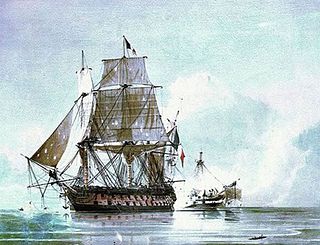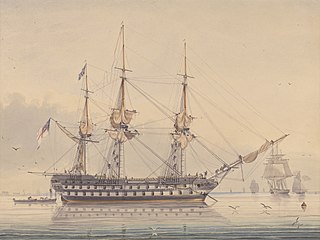
HMS Tonnant was an 80-gun ship of the line of the Royal Navy. She had previously been Tonnant of the French Navy and the lead ship of the Tonnant class. The British captured her in August 1793 during the Siege of Toulon but the French recaptured her when the siege was broken in December. Rear-Admiral Horatio Nelson captured her at Aboukir Bay off the coast of Egypt at the Battle of the Nile on 1 August 1798. She was taken into British service as HMS Tonnant. She went on to fight at the Battle of Trafalgar in 1805, during the Napoleonic Wars.

HMS Leander was a Portland-class 50-gun fourth rate of the Royal Navy, launched at Chatham on 1 July 1780. She served on the West Coast of Africa, West Indies, and the Halifax station. During the French Revolutionary Wars she participated in the Battle of the Nile before a French ship captured her. The Russians and Turks recaptured her and returned her to the Royal Navy in 1799. On 23 February 1805, while on the Halifax station, Leander captured the French frigate Ville de Milan and recaptured her prize, HMS Cleopatra. On 25 April 1805, cannon fire from Leander killed an American seaman while Leander was trying to search an American vessel off the US coast for contraband. The resulting "Leander affair" contributed to the worsening of relations between the United States and Great Britain. In 1813, the Admiralty converted Leander to a hospital ship under the name Hygeia. Hygeia was sold in 1817.
HMS Ganges was a 74-gun third-rate ship of the line of the Royal Navy, launched in 1782 at Rotherhithe. She was the first ship of the Navy to bear the name, and was the name ship of her class. She saw active service from 1782 to 1811, in Europe and the West Indies.

During the Napoleonic Wars, the Anglo-Russian War was the phase of hostilities between Great Britain and Russia after the latter signed the Treaty of Tilsit that ended its war with France. Anglo-Russian hostilities were limited primarily to minor naval actions in the Baltic Sea and Barents Sea.

HMS Polyphemus, a 64-gun third-rate ship of the line of the Royal Navy, launched on 27 April 1782 at Sheerness. She participated in the 1801 Battle of Copenhagen, the Battle of Trafalgar, and the Siege of Santo Domingo. In 1813 she became a powder hulk and was broken up in 1827.

HMS Boadicea was a frigate of the Royal Navy. She served in the Channel and in the East Indies during which service she captured many prizes. She participated in one action for which the Admiralty awarded the Naval General Service Medal. She was broken up in 1858.

HMS Donegal was launched in 1794 as Barra, a Téméraire class 74-gun ship of the line of the French Navy. She was renamed Pégase in October 1795, and Hoche in December 1797. The British Royal Navy captured her at the Battle of Tory Island on 12 October 1798 and recommissioned her as HMS Donegal.

HMS Gladiator was a 44-gun fifth-rate Roebuck-class ship of the Royal Navy. She was launched on 20 January 1783 by Henry Adams of Bucklers Hard. She spent her entire career on harbour service, never putting to sea. Even so, her crew earned prize money for the seizure of two Russian and five American ships. Her sessile existence made her an excellent venue for courts-martial and a number of notable ones took place aboard her. She was broken up in 1817.
HMS Staunch was a Royal Navy 12-gun Archer-class gun-brig, built by Benjamin Tanner and launched in 1804 at Dartmouth, Devon. She served in the Indian Ocean and participated in the action of 18 September 1810 before she foundered with the loss of all hands in 1811.

HMS Frolic was an 18-gun Cruizer-class brig-sloop of the Royal Navy. She was built by Boole, of Bridport and was launched on 9 February 1806. Although she took part in the capture of Martinique, Guadaloupe, and Saint Martin, she appears to have had an uneventful career until 8 October 1812, when the American sloop-of-war USS Wasp captured her after a fierce fight. Later that day the British recaptured Frolic and captured Wasp. Frolic was broken up in 1813.
HMS Circe was a Royal Navy 32-gun fifth-rate frigate, built by Master Shipwright Joseph Tucker at Plymouth Dockyard, and launched in 1804. She served in the Caribbean during the Napoleonic Wars, and participated in an action and a campaign for which in 1847 in the Admiralty authorised the issuance of the Naval General Service Medal with clasps. The action, off the Pearl Rock, near Saint-Pierre, Martinique, was a debacle that cost Circe dearly. However, she also had some success in capturing privateers and a French brig. She was sold in 1814.

HMS Salsette was a Perseverance-class fifth-rate frigate of a nominal 36 guns, launched in 1805. The East India Company built her for the Royal Navy at the company's dockyards in Bombay. She was the Navy's first teak-built ship.
Puissant was built in 1781-82 to a design by Antoine Groignard as a Pégase class 74-gun ship of the line. Her captain handed her over to the British at Toulon on 29 August 1793. She arrived at Portsmouth on 3 May 1794. She then remained there as an unarmed receiving ship, sheer hulk, and flagship until her sale in 1816.

The French brig Voltigeur was a Palinure-class brig launched in 1804. The British captured her in 1806 and renamed her HMS Pelican. She was sold in 1812.
HMS Adonis was the name vessel of her class of schooners of the Royal Navy during the Napoleonic War. She was built at Bermuda using Bermudan cedar and completed in 1806. She had a relatively uneventful career, primarily on the Newfoundland station, before the Admiralty sold her in 1814. She then became the mercantile Adonis and sailed to Africa and the Indian Ocean until she was wrecked in June 1835 on the Maldive Islands.

HMS Moselle was a Cruizer-class brig-sloop of the Royal Navy, launched in 1804. She served during the Napoleonic Wars in the Mediterranean, the Caribbean, and the North American station. She was sold in 1815.
HMS Buffalo was a storeship under construction as the merchant vessel Fremantle when the Royal Navy purchased her on the stocks. She was launched in 1797, and sold in 1817.
HMS Milbrook was one of six vessels built to an experimental design by Sir Samuel Bentham. After the Royal Navy took her into service in her decade-long career she took part in one notable single-ship action and captured several privateers and other vessels, all off the coast of Spain and Portugal. She was wrecked off the coast of Portugal in 1808.

HMS Crocodile was a 22-gun sixth-rate post-ship launched in South Shields in 1806. She was broken up at Portsmouth in October 1816.
HMS Coquette was launched in 1807 and spent her naval career patrolling in the Channel and escorting convoys. In 1813 she engaged an American privateer in a notable but inconclusive single-ship action. The Navy put Coquette in ordinary in 1814 and sold her in 1817. She became a whaler and made five whaling voyages to the British southern whale fishery before she was lost in 1835 on her sixth.












